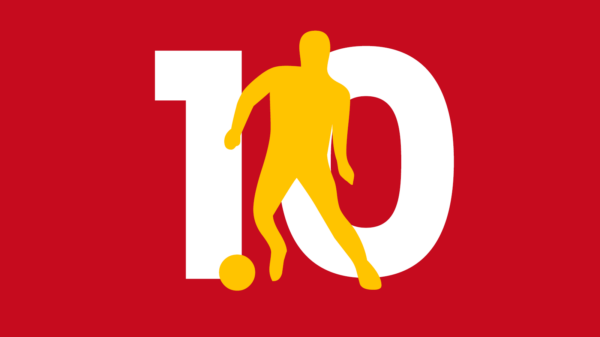This four part series focuses on the Atletico Madrid tactics deployed this season as they’re on course to stopping the duopoly in the Spanish La Liga while also being a fresh new wave in the latter stages of the UEFA Champions League.

The first part was a short piece on their basic formation, without going into too much detail. The second piece digs right into the tactics and analysed their build-up play in terms of attacking organisation.This third part, which is a continuation of the attacking analysis, details how Simeone’s men set-up in the attacking third in attacking phases. The final part analyses the factor which Atletico Madrid have received much praise for- their defensive set-up.
ATTACKING THIRD
The approach in the attacking third shows a more converging pattern, with the ball now immediately moving towards the center. The intent is now to primarily move the ball towards the 18 yard area. A delayed approach results in the ball being moved around to the edge of the area for long-range efforts.
The ball may either arrive from triangles out wide or from direct passes usually played to the false target-man. The attack then varies according to route of arrival of the ball.
Decoy Movement and Key Passes
Upon arrival of the ball from out wide, decoy movement is the most frequent plan undertaken from out wide. The full-back (usually – may differ with situation) moves wide and towards the by-line, apparently looking for a through ball from the wide playmaker. With the help of the decoy, the playmaker cuts in at the edge of the area.

The Decoy-run draws the defence away and makes room for the playmaker (Turan) to move towards the edge of the box.
This movement initially draws the opposition center backs towards the overloaded side, which creates room for movement beyond the centre- backs and away from their line of sight.
The movement of the false target-man towards the near post also creates much more room for the striker. Movement along the blind side of the opposition center back frees the striker from his marker, allowing him to rush into the space in the 18 yard box into which the ball is played by the wide playmaker.

With a prolific striker in the box, the Atletico Madrid playmakers frequently opt to whip the ball in behind the opposition defensive line.
Comment:
- Most key passes have come from the wide playmakers, with Koke averaging almost 2 key passes per game (52 key passes in 27 appearances). Turan averages 1.1 key passes every game.
- Koke has made the most cross attempts (202) and makes the most number of accurate crosses per game (1.7), establishing his role in chance creation through crosses.
- About 65% of the total shots have come from the middle, indicating that the striker and false target-man play an immensely vital role in converting play into a shot towards goal in the final third ( – this fact can most likely be attributed to the absence of wingers).
- Diego Costa makes the most attempts per game (3.3), followed by David Villa (2.2) and Raul Garcia (1.8). Under current league statistics, both Costa and Villa have been scoring a goal in every four attempts.
Full-back Overlap and Crosses
The ball is played through to the full-back (or player on the overlap) and a cross from the byline into the 18 yard box follows rather than the 6 yard box.

The attacking midfielder from the opposite flank (Koke) entersinto the box. The full-back makes the overlapping run and puts the ball into the 18 yard box
However, the team can be seen opting for frequent overlapping runs only during a favorable run of play. The striker and the false target-man both serve as targets for crosses arriving from deep positions into the 18 yard box.The attacking playmaker on the opposite side also moves into the 18 yard box when crosses are set to arrive from the byline. The full-back on the opposite side tries to recycle the over-hit crosses.
Comment:
- Preferred full-backs Felipe Luis and Juanfran have made a total of 190 cross attempts so far. However, the crosses have not been as accurate (only 0.7 accurate crosses per game) as those from wide playmakers like Koke and Turan.
- About 61% of attempts have come from the 18 yard box. The crosses are directed into this area to utilize the team’s aerial dominance.
The Knock-Down and Long-Range Shots
The long balls aimed at the false target-man now come into play. The False TM may station himself centrally or out wide to receive the pass.

The long pass is played towards the false TM (Garcia), while Turan aligns himself for the knock-down
The aerial passes are either knocked down onto the path of players positioned at the edge of the box for a long range effort, or looped over into the 18 yard box for the poacher.
Comment:
- Both players rotated in the false target-man role (Costa and Garcia) have been dominant in the air. The role serves as an attacking pivot and asserts the team’s physical abilities in the attacking third.
- Long-range efforts from outside the box sum up to 30% of the team’s total shots. Knock-downs are more efficient in creating room for a long-range strike since most opposition players are moving backwards during the time of the knock-down, and end up moving away from the ball while the shot is taken.
SET-PLAYS–Offensive
(12 of Atletico Madrid’s league goals have come from set pieces)
Corners
Koke is the preferred corner-kick taker. The false target-man, striker and center backs stay in the box for the corner, occasionally accompanied by a defensive midfielder (especially if the striker is not aerially accomplished).
The corner kick is usually floated towards the 18 yard area in line with the near-post, or the edge of the six yard area in line with the far-post. The false target-man, along with a center-back, moves towards the near-post. ThesStriker moves from a central location towards the far-post. The remaining center-back rushes towards the central area.
Free-kicks
Generally, the center-back pair, the false target-man and the striker stay in the box for offensive free kicks, with a defensive midfielder occasionally present (usually during central free kicks). One player (generally a wide playmaker) is positioned at the edge of the area.
1) Long Range
Long range free-kicks are generally taken short with Gabi as the preferred taker Occasionally the ball is directed towards a center-back running from behind the opposing full-back, who then tries to head the ball towards the middle of the box. This set-up, however, has seldom been effective, with the center back getting caught offside more often than wanted.
2) Close Range
– Wide Areas
Koke is the preferred free-kick taker from wide areas. The free kicks from wide are generally directed into the 18 yard area towards the aerially dominant players (Garcia, Costa, Godin, and Miranda).
Alternatively, a near post play is conducted, in which the ball is directed towards the near post. The striker pulls away towards the far post, drawing his marker away, while the false target-man makes a curved run towards the near post – often beating his marker to the ball and getting a shot on goal.

The ball is delivered to the 18 yard area in line with the near post. Garcia moves towards the area to beat the defender to the ball, and Diego Costa pulls out in the opposite direction, drawing defenders with him and making room for a shot on goal from Garcia
– Central Areas
Gabi is the usual free-kick taker from central areas. The free kicks from central areas are generally aimed towards goal, provided it is not an ‘indirect’ free kick and the site of foul is within the taker’s shooting distance. Free kicks away from shooting distance are directed in search of the best header towards the far post, as expected.
This piece was written by Sauharda Karki. Follow him on twitter @sodaboix
- Premier League: The Growing Trend Of Counter-Attacking Goals - June 11, 2020
- Analysis | Three Things We Learned: NorthEast United 0-1 Bengaluru FC - December 9, 2017
- Three Things We Learned: NorthEast United 0-0 Jamshedpur - November 19, 2017
























































